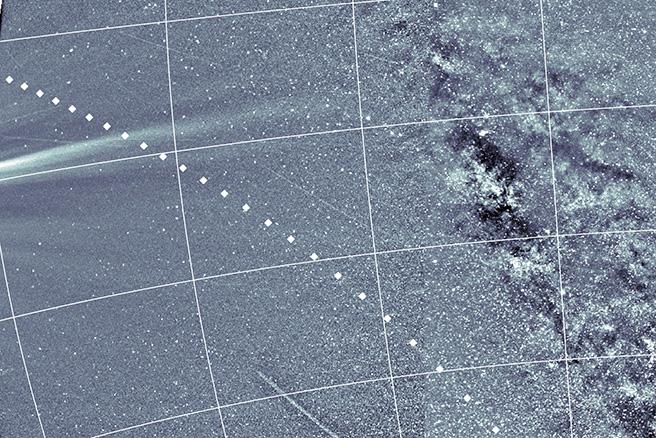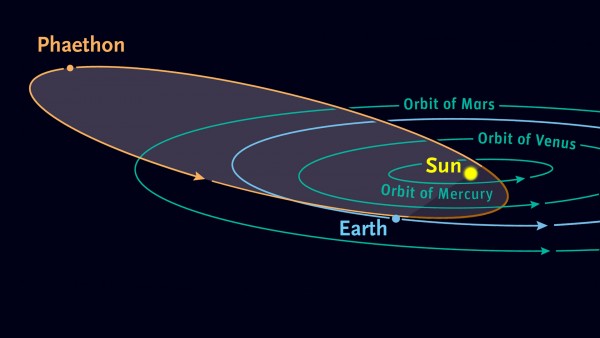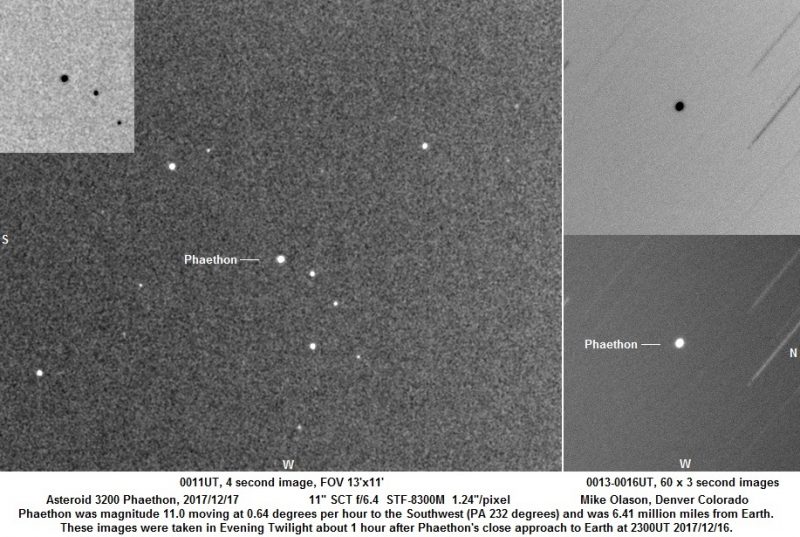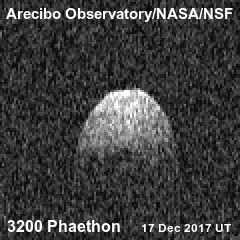

Artist’s concept of what asteroid 3200 Phaethon might look like close up. Notice its blue color and tail of dust. Image via Heather Roper/ UANews.
All annual meteor showers known to astronomers have comets as their sources, but not the Geminids. A quirky object known as 3200 Phaethon is the source of the Geminids, and scientists puzzle over how this asteroid can act so much like a comet, leaving behind a trail of debris that sparks a meteor shower.
What are the Geminids? The Geminid meteor shower is often one of the best annual showers of the year, with the peak occurring around December 13-14, though you may catch a Geminid anytime from about December 4 to 17. On great years, you can see more than 100 meteors an hour at the shower’s peak of activity. The slimmer the moon and darker the sky, the more meteors you’ll see.
The trails of dust left behind by comets (and 3200 Phaethon) are called meteoroid streams. The dust enters our atmosphere and vaporizes, producing the streaks of light we see as meteors or shooting stars. Last year (December 2019), astronomers at the U.S. Naval Research Laboratory held a press conference to discuss the first-ever image of a dust trail (below) left behind in space by 3200 Phaethon. At the time, Karl Battams – who goes by @SungrazerComets on Twitter – commented:
Something catastrophic happened to Phaethon a couple of thousand years ago and created the Geminid meteor shower. There’s no way the asteroid is anywhere near active enough when it is near the sun to produce the mass of dust we are seeing …
Battams said the asteroid dust trail weighs an estimated billion tons, and measures more than 14 million miles (23 million km) long.
So … most meteor showers are spawned by comets, which are fragile, icy bodies that litter their orbits with debris. It’s easy to see how debris from a comet’s orbit can create a shower of meteors in Earth’s sky. How does the rocky asteroid 3200 Phaethon do this? That’s the mystery.
Read more: NRL-camera aboard NASA spacecraft confirms asteroid phenomenon

View larger. | Look closely along the line of white dots. A faint dust trail is visible between the dots. This faint dust trail – left behind by 3200 Phaethon, parent body for the Geminid meteor shower – was captured for the first time in 2019 by a camera called WISPR aboard the Parker Solar Probe. Image via Brendan Gallagher/ Guillermo Stenborg/ U.S. Naval Research Lab.
The trail of debris behind the asteroid is not the only unusual thing about it. 3200 Phaethon is an odd color for an asteroid. Most asteroids are dull grey to red, depending on the type of material on their surface. 3200 Phaethon is blue. Blue asteroids are known, but make up only a fraction of all known asteroids. And Phaethon isn’t just blue. It’s one of the bluest of similarly-colored asteroids (or comets) in the solar system.
Here’s another odd feature of 3200 Phaethon. While comets tend to have more elliptical orbits, asteroid orbits are more circular. 3200 Phaethon’s orbit – which is now exceedingly well known – is highly elongated, reminiscent of some comets. Its orbit crosses the orbits of Mars, Earth, Venus and Mercury.
Plus its orbit brings 3200 Phaethon closer to the sun than any other named asteroid (though some smaller, unnamed asteroids come even closer). At its closest point, Phaethon is only 13 million miles (20.9 million km) from the sun. That’s less than half of Mercury’s closest distance.
Its name honors this object’s relationship to the sun, by the way. In Greek mythology, Phaethon was the son of the sun god Helios.
3200 Phaethon’s orbit carries it so close to the sun that its surface heats up to about 1,500 degrees Fahrenheit (800 degrees Celsius). That’s hot enough to melt aluminum.
It’s when it’s closest to the sun that 3200 Phaethon releases a tiny dust tail. Scientists have said it’s possible the sun’s heat causes fractures, in much the same way a dry riverbed cracks in the afternoon heat.

Orbital path of 3200 Phaethon. In 2017, Phaethon came closer to Earth than it will again until 2093. The Geminids are always a reliable shower, but the shower was extra special in 2017 because its parent object was nearby. Image via SkyandTelescope.com. See photos: With 3200 Phaethon nearby, 2017 was a grand year for the Geminids.
3200 Phaethon is classified as a potentially hazardous asteroid, which doesn’t mean it’s a threat to Earth. It just means two things. First, 3200 Phaethon is big – about 3 miles (5 km) wide – big enough to cause significant regional damage if it were to strike Earth.
Second, it’s known to make periodic close approaches to Earth. However, astronomers know of no upcoming strike by this object in this foreseeable future.
The 2017 encounter was the closest this object will come to Earth until 2093. It brought this object to about 26 times the moon’s distance.
Both amateur and professional astronomers watched 3200 Phaethon as carefully as they could in 2017. For example, Northolt Branch Observatories in London, England, created the animation below from images it captured in 2017.
Steven Bellavia also produced a video (below) of 3200 Phaethon in 2017. He commented then that he’d endured cloudy weather and sub-freezing temperatures in order to capture the images.
Mike Olason in Denver, Colorado, captured 3200 Phaethon on December 4, 2017:

Photos captured about an hour after Phaethon’s closest approach to Earth in 2017. Image via Mike Olason.

This closeup image of 3200 Phaethon by NASA’s STEREO A spacecraft in 2017 shows a tail extending faintly toward lower left. Image via NASA/ SkyandTelescope.com.

Radar images of 3200 Phaethon generated by astronomers at the Arecibo Observatory on December 17, 2017. Image via Wikipedia.
3200 Phaethon was the first asteroid to be discovered via spacecraft, on October 11, 1983. Astronomers Simon F. Green and John K. Davies noticed it while searching Infrared Astronomical Satellite (IRAS) data for moving objects. Charles T. Kowal confirmed it optically and said it was asteroid-like in appearance. The object received the provisional designation 1983 TB. Two years later, in 1985, using the convention for naming asteroids, astronomers assigned it its asteroid number and name: 3200 Phaethon.
Before 3200 Phaethon, scientists linked all known meteor showers to comets and not asteroids.
Thus 3200 Phaethon surprised them from the beginning, because – while it looked like an asteroid – it appeared to be the source of the annual Geminid meteor shower. Astronomers began calling 3200 Phaethon a comet-asteroid hybrid, an asteroid that behaves like a comet. Later, they began using the term rock-comet.
What else will we learn about this object, as the years pass?

The composition of 3200 Phaethon resembles that of asteroid 2 Pallas. Both are dark, B-type asteroids composed of materials that have been modified by water. The 1st in this series of Hubble images of 3200 Phaethon in 2017 is marked with the asteroid’s spin axis (top) and south pole. Image via B.E. Schmidt et al./ NASA/ ESA/ SkyandTelescope.com.
Bottom line: The Geminid meteor shower has a unique source – 3200 Phaethon – sometimes called a comet-asteroid hybrid, or a rock-comet.
See photos: With 3200 Phaethon nearby, 2017 was a grand year for the Geminids
from EarthSky https://ift.tt/36tfYtd


Artist’s concept of what asteroid 3200 Phaethon might look like close up. Notice its blue color and tail of dust. Image via Heather Roper/ UANews.
All annual meteor showers known to astronomers have comets as their sources, but not the Geminids. A quirky object known as 3200 Phaethon is the source of the Geminids, and scientists puzzle over how this asteroid can act so much like a comet, leaving behind a trail of debris that sparks a meteor shower.
What are the Geminids? The Geminid meteor shower is often one of the best annual showers of the year, with the peak occurring around December 13-14, though you may catch a Geminid anytime from about December 4 to 17. On great years, you can see more than 100 meteors an hour at the shower’s peak of activity. The slimmer the moon and darker the sky, the more meteors you’ll see.
The trails of dust left behind by comets (and 3200 Phaethon) are called meteoroid streams. The dust enters our atmosphere and vaporizes, producing the streaks of light we see as meteors or shooting stars. Last year (December 2019), astronomers at the U.S. Naval Research Laboratory held a press conference to discuss the first-ever image of a dust trail (below) left behind in space by 3200 Phaethon. At the time, Karl Battams – who goes by @SungrazerComets on Twitter – commented:
Something catastrophic happened to Phaethon a couple of thousand years ago and created the Geminid meteor shower. There’s no way the asteroid is anywhere near active enough when it is near the sun to produce the mass of dust we are seeing …
Battams said the asteroid dust trail weighs an estimated billion tons, and measures more than 14 million miles (23 million km) long.
So … most meteor showers are spawned by comets, which are fragile, icy bodies that litter their orbits with debris. It’s easy to see how debris from a comet’s orbit can create a shower of meteors in Earth’s sky. How does the rocky asteroid 3200 Phaethon do this? That’s the mystery.
Read more: NRL-camera aboard NASA spacecraft confirms asteroid phenomenon

View larger. | Look closely along the line of white dots. A faint dust trail is visible between the dots. This faint dust trail – left behind by 3200 Phaethon, parent body for the Geminid meteor shower – was captured for the first time in 2019 by a camera called WISPR aboard the Parker Solar Probe. Image via Brendan Gallagher/ Guillermo Stenborg/ U.S. Naval Research Lab.
The trail of debris behind the asteroid is not the only unusual thing about it. 3200 Phaethon is an odd color for an asteroid. Most asteroids are dull grey to red, depending on the type of material on their surface. 3200 Phaethon is blue. Blue asteroids are known, but make up only a fraction of all known asteroids. And Phaethon isn’t just blue. It’s one of the bluest of similarly-colored asteroids (or comets) in the solar system.
Here’s another odd feature of 3200 Phaethon. While comets tend to have more elliptical orbits, asteroid orbits are more circular. 3200 Phaethon’s orbit – which is now exceedingly well known – is highly elongated, reminiscent of some comets. Its orbit crosses the orbits of Mars, Earth, Venus and Mercury.
Plus its orbit brings 3200 Phaethon closer to the sun than any other named asteroid (though some smaller, unnamed asteroids come even closer). At its closest point, Phaethon is only 13 million miles (20.9 million km) from the sun. That’s less than half of Mercury’s closest distance.
Its name honors this object’s relationship to the sun, by the way. In Greek mythology, Phaethon was the son of the sun god Helios.
3200 Phaethon’s orbit carries it so close to the sun that its surface heats up to about 1,500 degrees Fahrenheit (800 degrees Celsius). That’s hot enough to melt aluminum.
It’s when it’s closest to the sun that 3200 Phaethon releases a tiny dust tail. Scientists have said it’s possible the sun’s heat causes fractures, in much the same way a dry riverbed cracks in the afternoon heat.

Orbital path of 3200 Phaethon. In 2017, Phaethon came closer to Earth than it will again until 2093. The Geminids are always a reliable shower, but the shower was extra special in 2017 because its parent object was nearby. Image via SkyandTelescope.com. See photos: With 3200 Phaethon nearby, 2017 was a grand year for the Geminids.
3200 Phaethon is classified as a potentially hazardous asteroid, which doesn’t mean it’s a threat to Earth. It just means two things. First, 3200 Phaethon is big – about 3 miles (5 km) wide – big enough to cause significant regional damage if it were to strike Earth.
Second, it’s known to make periodic close approaches to Earth. However, astronomers know of no upcoming strike by this object in this foreseeable future.
The 2017 encounter was the closest this object will come to Earth until 2093. It brought this object to about 26 times the moon’s distance.
Both amateur and professional astronomers watched 3200 Phaethon as carefully as they could in 2017. For example, Northolt Branch Observatories in London, England, created the animation below from images it captured in 2017.
Steven Bellavia also produced a video (below) of 3200 Phaethon in 2017. He commented then that he’d endured cloudy weather and sub-freezing temperatures in order to capture the images.
Mike Olason in Denver, Colorado, captured 3200 Phaethon on December 4, 2017:

Photos captured about an hour after Phaethon’s closest approach to Earth in 2017. Image via Mike Olason.

This closeup image of 3200 Phaethon by NASA’s STEREO A spacecraft in 2017 shows a tail extending faintly toward lower left. Image via NASA/ SkyandTelescope.com.

Radar images of 3200 Phaethon generated by astronomers at the Arecibo Observatory on December 17, 2017. Image via Wikipedia.
3200 Phaethon was the first asteroid to be discovered via spacecraft, on October 11, 1983. Astronomers Simon F. Green and John K. Davies noticed it while searching Infrared Astronomical Satellite (IRAS) data for moving objects. Charles T. Kowal confirmed it optically and said it was asteroid-like in appearance. The object received the provisional designation 1983 TB. Two years later, in 1985, using the convention for naming asteroids, astronomers assigned it its asteroid number and name: 3200 Phaethon.
Before 3200 Phaethon, scientists linked all known meteor showers to comets and not asteroids.
Thus 3200 Phaethon surprised them from the beginning, because – while it looked like an asteroid – it appeared to be the source of the annual Geminid meteor shower. Astronomers began calling 3200 Phaethon a comet-asteroid hybrid, an asteroid that behaves like a comet. Later, they began using the term rock-comet.
What else will we learn about this object, as the years pass?

The composition of 3200 Phaethon resembles that of asteroid 2 Pallas. Both are dark, B-type asteroids composed of materials that have been modified by water. The 1st in this series of Hubble images of 3200 Phaethon in 2017 is marked with the asteroid’s spin axis (top) and south pole. Image via B.E. Schmidt et al./ NASA/ ESA/ SkyandTelescope.com.
Bottom line: The Geminid meteor shower has a unique source – 3200 Phaethon – sometimes called a comet-asteroid hybrid, or a rock-comet.
See photos: With 3200 Phaethon nearby, 2017 was a grand year for the Geminids
from EarthSky https://ift.tt/36tfYtd

Aucun commentaire:
Enregistrer un commentaire